SafePal Wallet Review (2025)



Editorial Note: While we adhere to strict Editorial Integrity, this post may contain references to products from our partners. Here's an explanation for How We Make Money. None of the data and information on this webpage constitutes investment advice according to our Disclaimer.
SafePal Wallets (X1, S1, and S1 Pro) are still a reliable and budget-friendly option for securing your crypto assets offline in 2025. With support for over 10,000 tokens, mobile-first tools, and strong security features like air-gapped QR code signing and EAL5+ secure chips, SafePal offers a solid mix of safety, convenience, and cost-effectiveness.
SafePal has become known for delivering secure wallets that are easy to use at an affordable cost. In this review, we’ll examine closely SafePal’s full hardware wallet lineup, including the X1, S1, and S1 Pro. We’ll review essential features, how they compare, pricing, supported coins, mobile app functions, as well as comparable alternatives.
Risk warning: Cryptocurrency markets are highly volatile, with sharp price swings and regulatory uncertainties. Research indicates that 75-90% of traders face losses. Only invest discretionary funds and consult an experienced financial advisor.
SafePal Wallet overview
SafePal makes three hardware wallets that prioritize security, convenience, and affordability:
SafePal X1 is their newest USB-C wallet — just plug it in, and you’re ready to go.
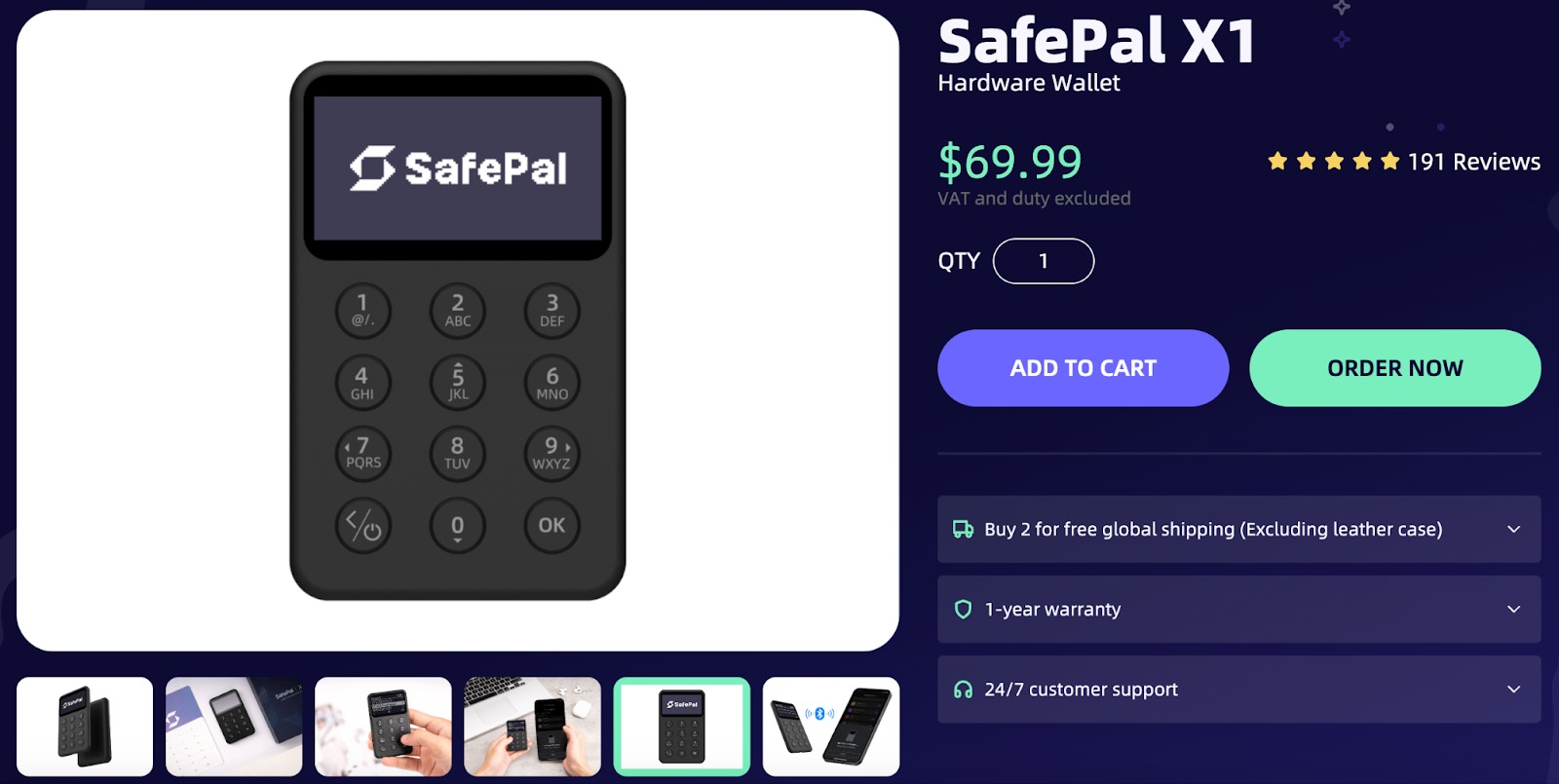
SafePal S1 keeps things completely offline by using QR codes to sign transactions — no Bluetooth, no cables.
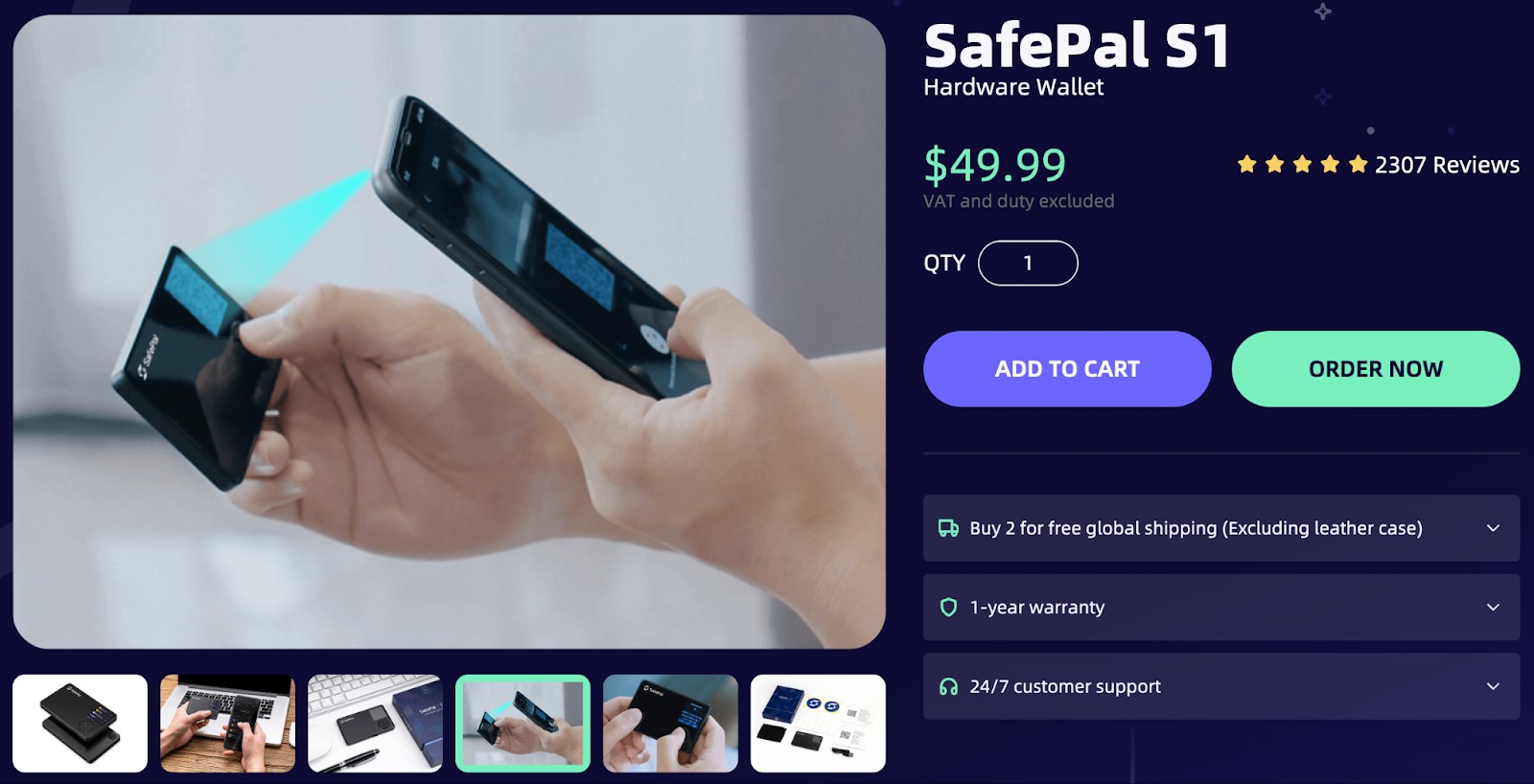
SafePal S1 Pro builds on the original with faster speed, a clearer screen, and better battery life.
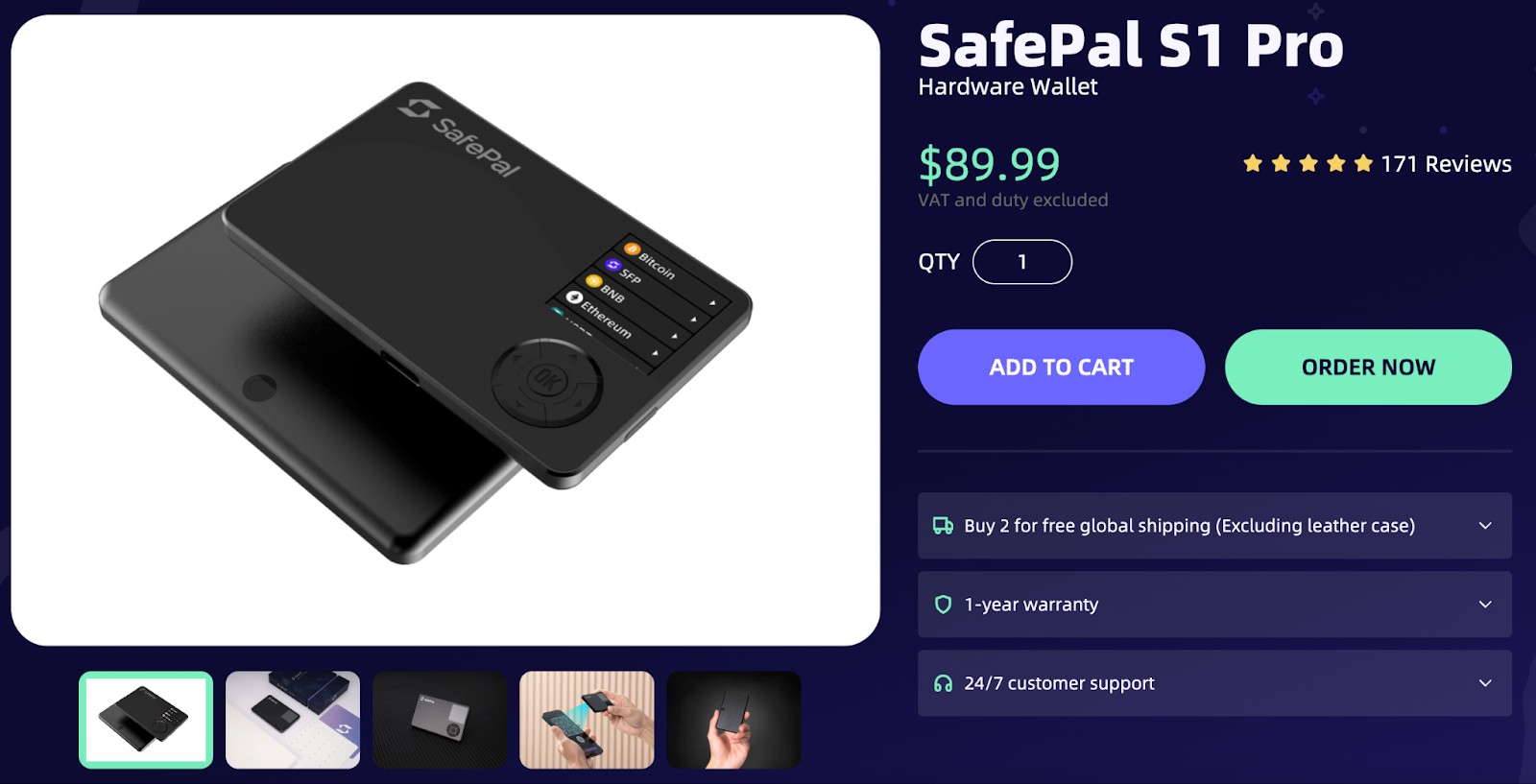
All three are built for mobile-first users who want a simple, secure way to manage their crypto. They pair easily with the SafePal app and give you full control over your assets — no subscriptions or hidden fees.
Air-gapped vs USB
The S1 and S1 Pro never connect to the internet, either physically or wirelessly. They sign transactions using QR codes, which keeps them safe from most remote attacks. This setup is perfect for users who want complete offline protection.
The X1 uses a USB-C cable to manage your crypto and sign transactions directly. It’s not fully offline, but it stays secure with encrypted transfers and a built-in security chip. If you care more about speed and ease than staying offline, the X1 might be a better fit.
Connectivity
SafePal X1 plugs into phones and computers with a USB-C cable using the SafePal app. S1 and S1 Pro use the camera to scan QR codes—no Bluetooth, WiFi, or cables involved.
Because there’s no wireless connection on the S1 models, there are fewer ways for someone to try to break in. The X1, meanwhile, offers a faster plug-and-go experience.
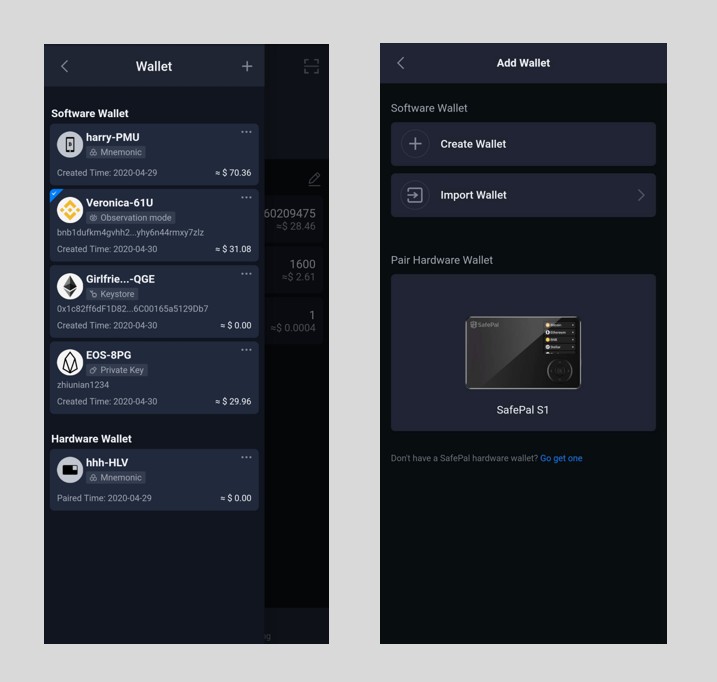
Battery
Both the S1 and S1 Pro have built-in batteries, but the Pro lasts longer, which is handy for frequent use or travel.
The X1 doesn’t have a battery — it powers up through USB-C, so you never need to charge it or worry about battery life.
Supported coins
SafePal lets you manage popular assets such as BTC, ETH, BNB, SOL, TRX, MATIC, DOT, and more. It works seamlessly with both mainnets and token standards like ERC-20, BEP-20, TRC-20, and SPL.

It also connects with Binance DEX, so you can trade directly without ever exposing your private keys. This makes SafePal ideal for both frequent traders and those holding long term. Since it works with over 10,000 tokens, you don’t have to jump between different wallets. The app keeps everything organized in one spot.
Open-source status
While SafePal hasn't made all of its code open-source, they've shared some parts of the firmware and app with the public. Tech-savvy users might lean towards completely open-source options, yet SafePal's security measures have earned positive feedback from the community. For those prioritizing full transparency, this could be a drawback when compared to wallets like Keystone or Ledger, which offer open-source UI components.
Security chip
Every SafePal model incorporates an EAL5+ Secure Element chip, matching the security standards found in banking hardware. This chip keeps your private keys encrypted and safely isolated. It also guards against physical attacks, tampering, and efforts to extract sensitive data — even if someone gets hold of your device.
SafePal wallets price
When evaluating SafePal's hardware wallets, it's intriguing to note that the SafePal X1, priced at $69.99, offers features comparable to the Ledger Nano X, which is listed at €149. Both devices support USB-C connectivity and Bluetooth, and are equipped with a CC EAL5+ secure element chip. However, the SafePal X1 provides these functionalities at less than half the cost, presenting a compelling value proposition for users seeking advanced security without the premium price tag.
Additionally, SafePal's commitment to affordability is evident across its product range. The SafePal S1 hardware wallet is available for $49.99, offering a cost-effective solution without compromising on security features. For those seeking enhanced specifications, the SafePal S1 Pro is priced at $89.99, still remaining competitively priced compared to other market alternatives. This strategic pricing underscores SafePal's dedication to making secure crypto storage accessible to a broader audience.
Who is SafePal wallet best for?
| Feature | SafePal X1 | SafePal S1 | SafePal S1 Pro |
|---|---|---|---|
| Build & Design | Compact, USB-based, no display | Larger screen, physical buttons, uses QR scanning | Bigger screen, faster performance, improved battery |
| User Type | Ideal for plug-and-play users, beginners | Balanced choice for general users | Best for active traders and long-term holders |
| Convenience | Simple setup, no camera needed | Requires phone + device + camera, slower process | Same as S1 but with smoother performance |
| Security Level | Good for quick access, not ideal for cold storage | High security, fully air-gapped QR communication | Higher performance cold wallet with top-tier security |
X1 is ideal for beginners and desktop users who want quick setup and USB convenience.
S1 suits privacy-conscious users who want maximum offline security.
S1 Pro is best for power users who frequently transact and need better battery, display, and performance.
Pros and cons of SafePal wallets
- Pros
- Cons
No live connection even during QR scanning. Unlike most wallets that go briefly online during QR code scanning, SafePal keeps the private key environment completely air-gapped, even while executing transactions — this eliminates exposure during those crucial seconds.
Burn-proof asset recovery. If your SafePal device is physically damaged (burnt, broken, etc.), the recovery using mnemonic phrases is fully optimized for even non-techies via their guided offline recovery flow, which feels more like restoring a phone than a wallet.
Integrated swap avoids KYC traps. Built-in DEX access inside the wallet means you can swap tokens without touching centralized exchanges — this is gold for users avoiding KYC flags or jurisdictional exposure.
Offline ≠ invisible to supply chain backdoors. Just because it's offline doesn’t mean it’s immune — if you bought SafePal from unofficial sources, the firmware could be tampered with. Always verify signatures via their GitHub before first use.
Can't mix UTXOs manually. If you’re using Bitcoin, SafePal lacks advanced coin control for UTXO management, which can leak your privacy in multi-input transactions — privacy nerds, beware.
Firmware upgrades can trap you. Missing a firmware update for too long? Some token standards (like new ERCs or BRC updates) might not be supported retroactively. You could get locked out of interacting with newer assets.
SafePal X1 setup via USB-C
Step 1: Connect the X1 to your device
Plug the X1 into your PC or smartphone using the USB-C cable. Make sure it powers on and is securely connected so the SafePal app can detect the device.
Step 2: Launch the SafePal app
Open the SafePal app on your phone or computer. If it’s not installed yet, download it from the official app store and ensure Bluetooth is off for a smooth wired setup.
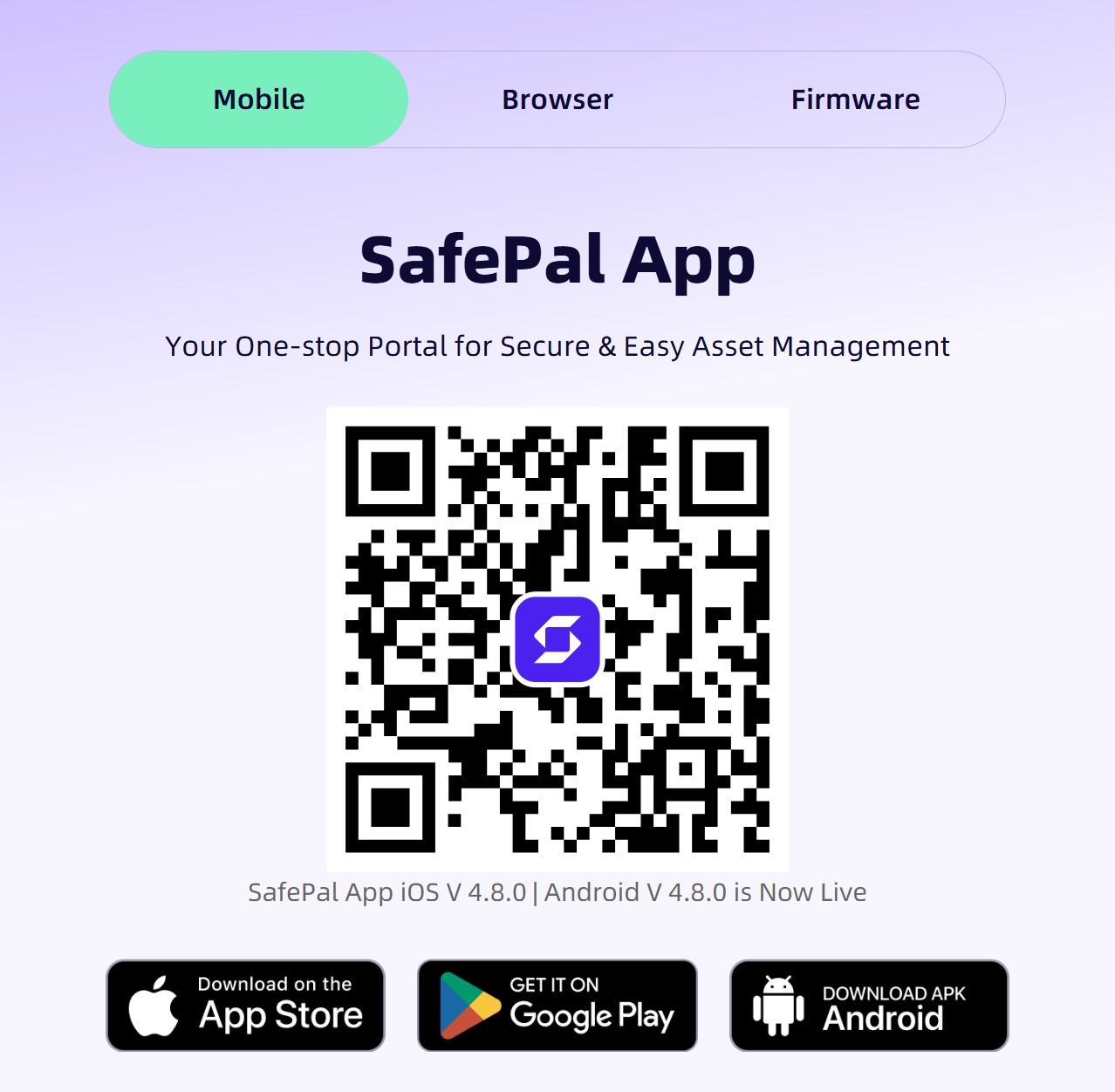
Step 3: Create or import a wallet
Follow the prompts in the app to either create a new wallet or import an existing one. Be sure to write down and safely store your recovery phrase during this step.
Step 4: Initialize the wallet
After creating or importing your wallet, the X1 will complete its initialization. You’ll get a confirmation in the app once everything is securely set up and ready to use.
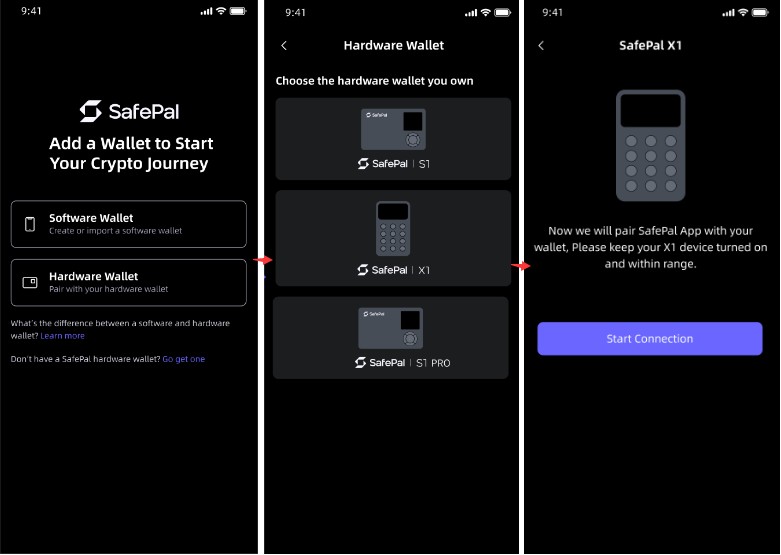
Step 5: Manage your crypto assets
With the wallet active, you can now send, receive, and manage your cryptocurrencies. Every transaction is confirmed through the X1, adding a strong layer of security.
Step 6: Access DApps and DeFi
Use the SafePal app to connect to decentralized apps while keeping your private keys offline. The X1 signs transactions securely, letting you explore Web3 safely.

SafePal S1 & S1 Pro setup via QR scanning
Step 1: Power on the device and begin pairing
Turn on your SafePal hardware wallet and open the SafePal app on your phone. Scan the QR code shown in the app to start the pairing process between the device and the app.

Step 2: Create or import your wallet
After pairing, follow the prompts to create a new wallet or import an existing one. You’ll need to securely back up your recovery phrase during this step.
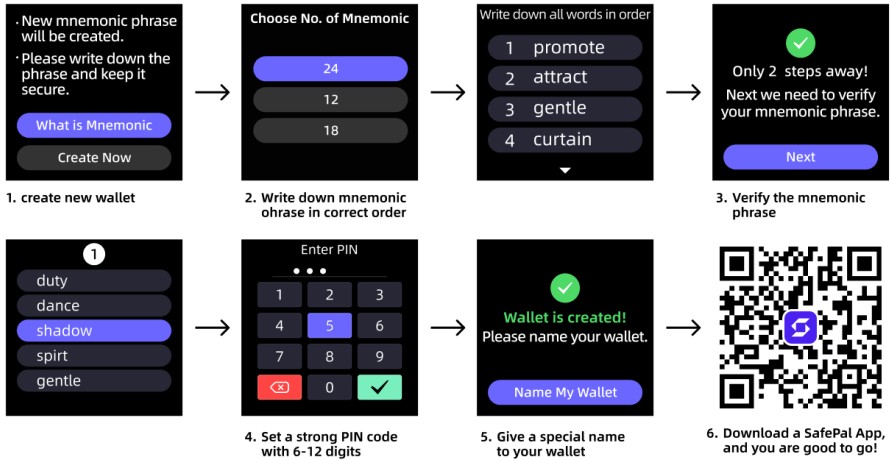
Step 3: Send transactions securely
When sending crypto, the app generates a QR code with the transaction details. Use the device camera to scan it, then sign the transaction and display a response QR code.
Step 4: Finalize the transaction in the app
Scan the signed QR code back into the SafePal app to complete the transaction. This process keeps your private keys offline, ensuring maximum security.
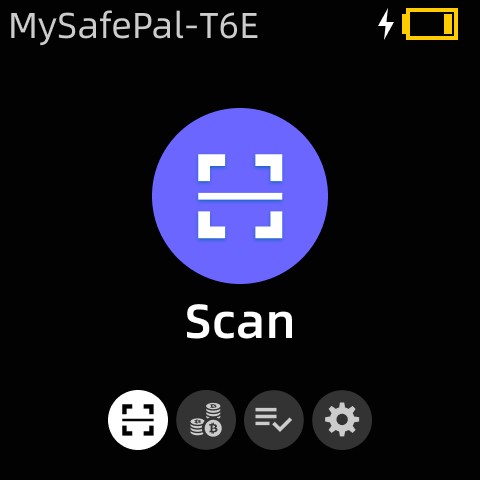
Alternatives to SafePal wallets
ELLIPAL Titan
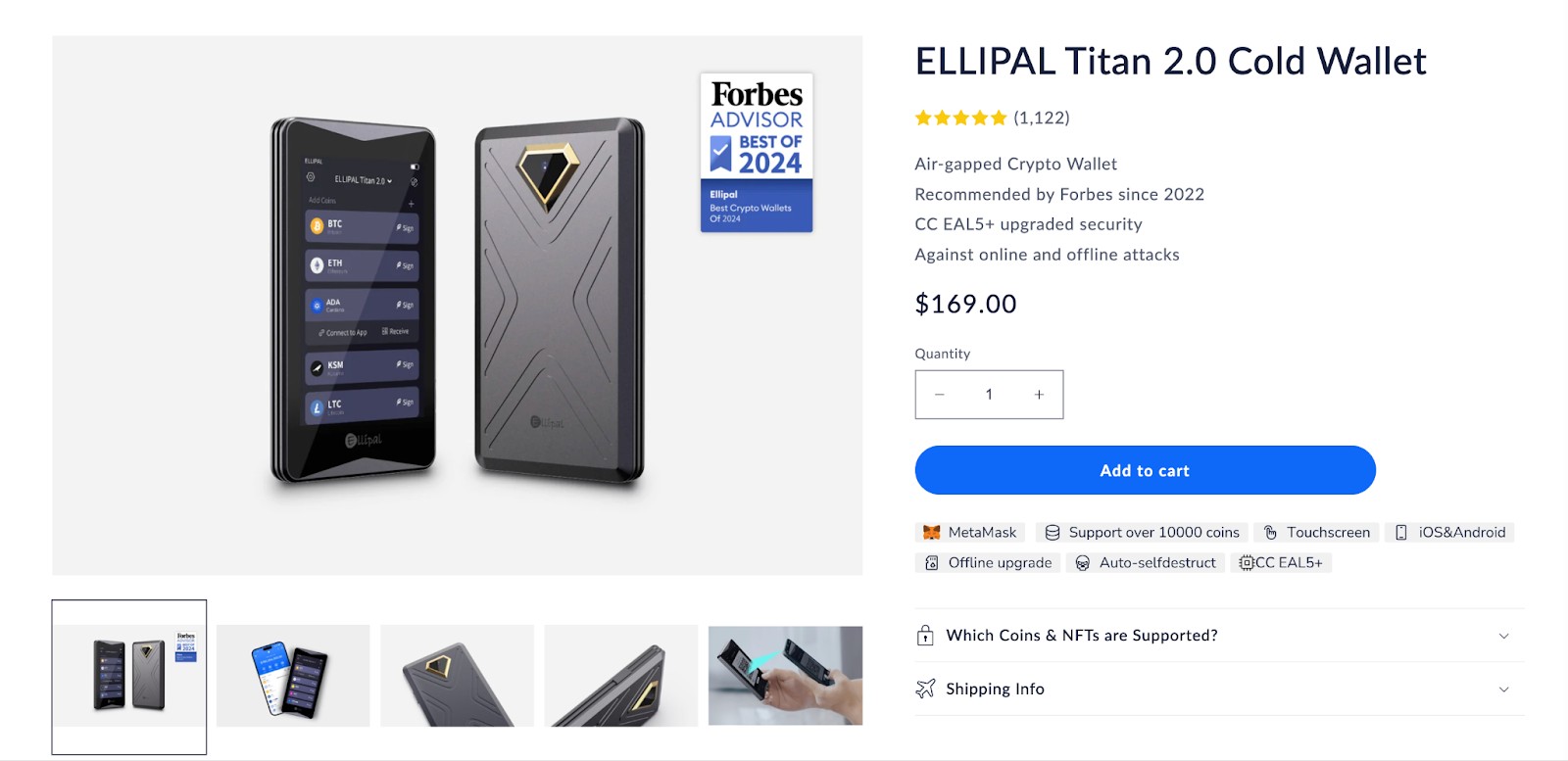
ELLIPAL comes with complete air-gap protection and a sturdy metal build, making it well-suited for those who prioritize physical safety alongside digital security. It’s priced higher but includes a touchscreen, which adds ease of use. Ideal for users who are ready to invest more for full cold storage confidence.
Keystone Pro
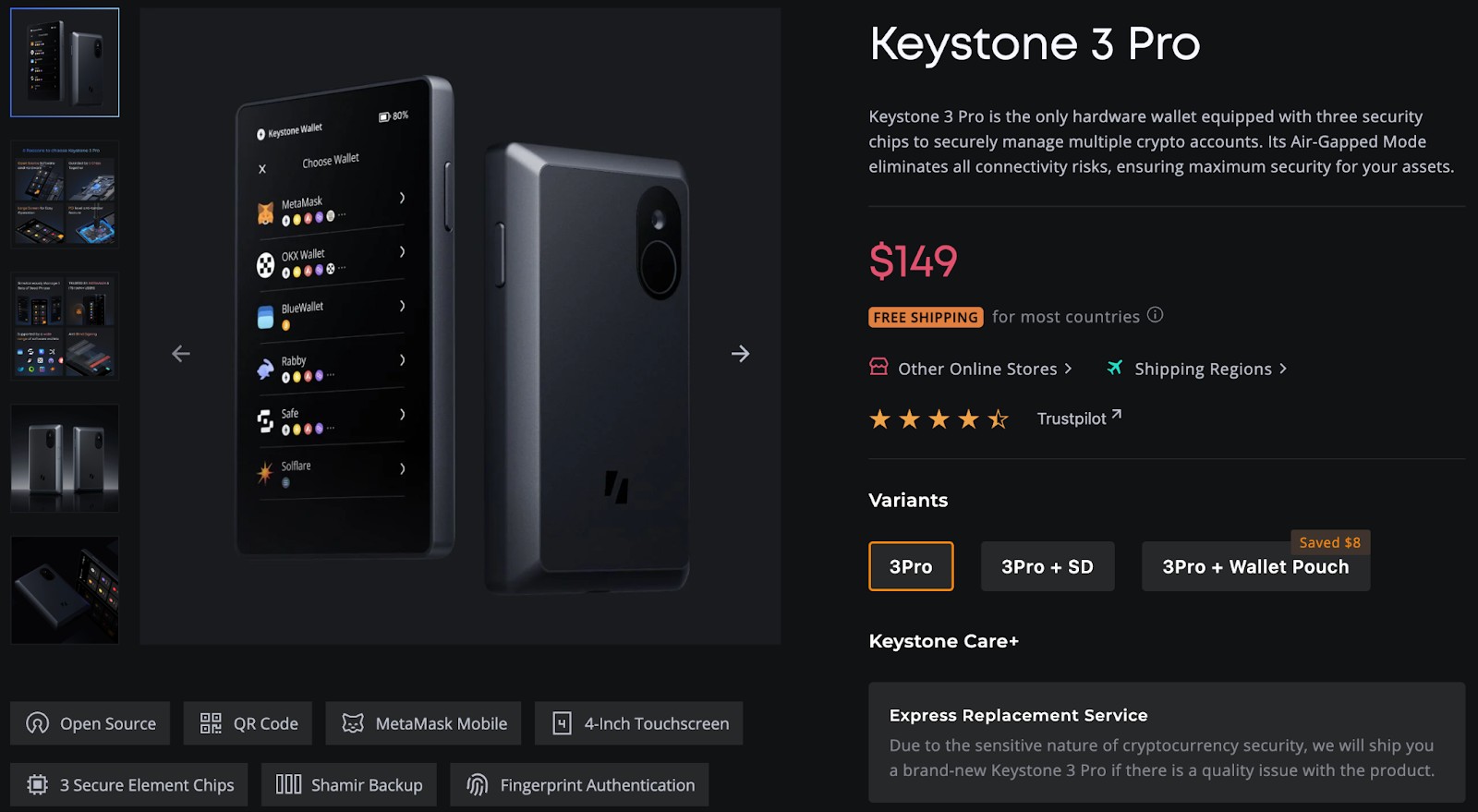
Keystone relies on QR-based signing and runs on open-source firmware, appealing to users who value transparency. It combines strong security features with a polished touchscreen design.
Ledger Nano S Plus
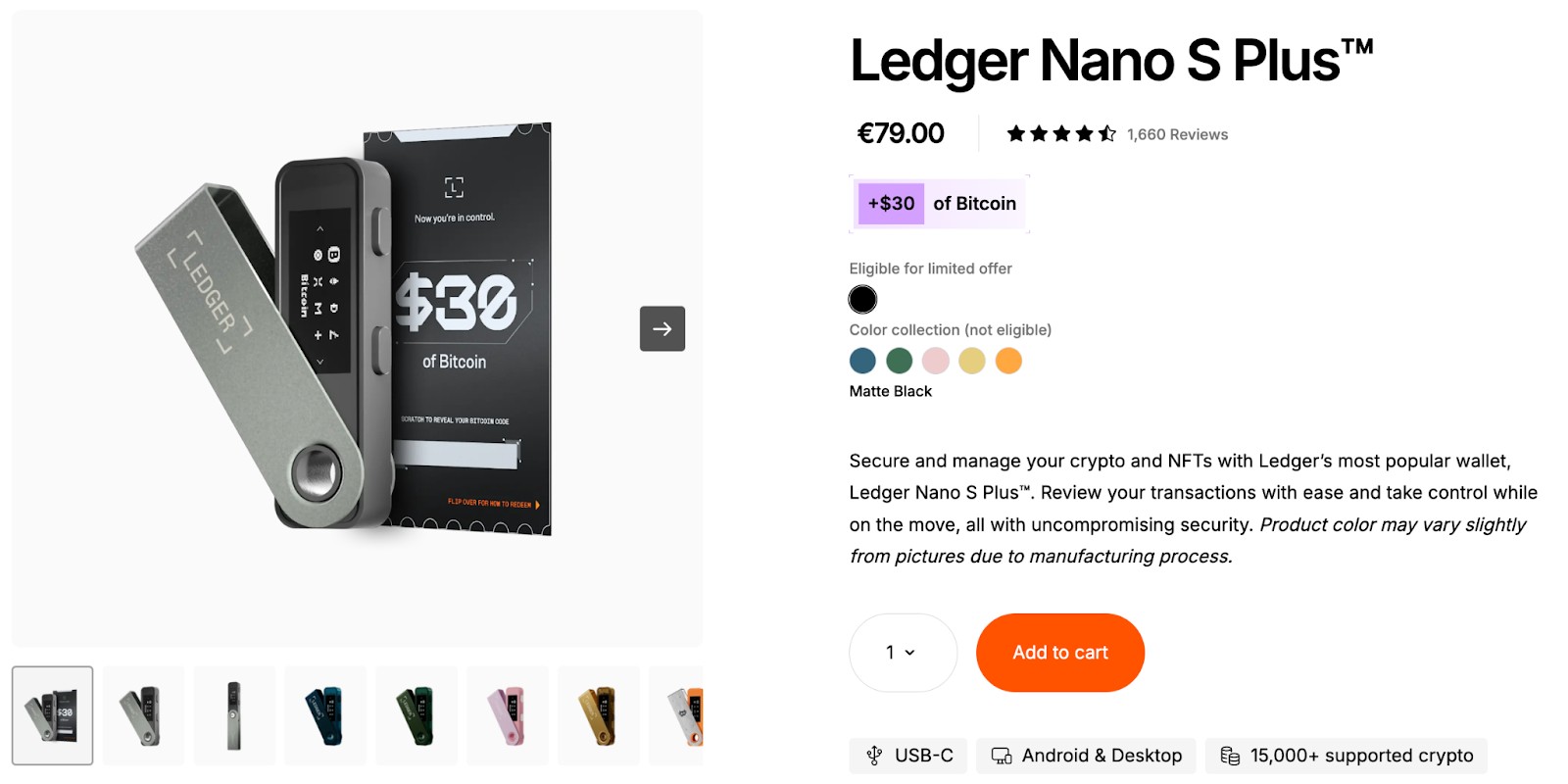
The Nano S Plus is a straightforward and budget-friendly hardware wallet that connects via USB and works seamlessly with Ledger Live. While it lacks air-gapping, it’s easy to operate and supports a wide range of assets. Suitable for users who prefer desktop-based wallets and trust Ledger’s overall platform.
Storing crypto on exchanges: An alternative to hardware wallets
While leaving crypto on exchanges may seem convenient, it's not the safest method. You're trusting a third party with your private keys, making them a target for hacks or policy changes. Regulation is one of the key parameters to judge the security of any exchange. In line with the same, the top exchanges known for their reliable security (and strict regulatory oversight) are listed in the table below:
| Crypto | Foundation year | Min. Deposit, $ | Coins Supported | Spot Taker fee, % | Spot Maker Fee, % | Alerts | Copy trading | Tier-1 regulation | TU overall score | Open an account | |
|---|---|---|---|---|---|---|---|---|---|---|---|
| Yes | 2011 | 10 | 278 | 0,4 | 0,25 | Yes | Yes | Yes | 8.48 | Open an account Your capital is at risk. |
|
| Yes | 2016 | 1 | 250 | 0,5 | 0,25 | Yes | No | Yes | 8.36 | Open an account Your capital is at risk. |
|
| Yes | 2018 | 1 | 72 | 0,2 | 0,1 | Yes | Yes | Yes | 7.41 | Open an account Your capital is at risk. |
|
| Yes | 2012 | 10 | 249 | 0,5 | 0,5 | Yes | No | Yes | 6.89 | Open an account Your capital is at risk. |
|
| Yes | 2021 | 10 | 474 | 0,1 | 0,08 | No | Yes | Yes | 5.65 | Open an account Your capital is at risk.
|
Why trust us
We at Traders Union have over 14 years of experience in financial markets, evaluating cryptocurrency exchanges based on 140+ measurable criteria. Our team of 50 experts regularly updates a Watch List of 200+ exchanges, providing traders with verified, data-driven insights. We evaluate exchanges on security, reliability, commissions, and trading conditions, empowering users to make informed decisions. Before choosing a platform, we encourage users to verify its legitimacy through official licenses, review user feedback, and ensure robust security features (e.g., HTTPS, 2FA). Always perform independent research and consult official regulatory sources before making any financial decisions.
Learn more about our methodology and editorial policies.
However, it's best to know that a hardware wallet like SafePal ensures you own your keys, giving you full control and access at all times, even if the internet disappears.
SafePal quietly ties you to Binance and why seed generation matters more than you think
If you’re eyeing the SafePal S1 in 2025, don’t just look at its specs — look at the ecosystem it silently locks you into. SafePal isn’t just a wallet, it’s a gateway to Binance's broader infrastructure. From token swaps to staking and bridging, most in-app functions are routed through Binance-affiliated services. That means if you’re someone who wants to stay decentralized or anonymous, you're still technically dancing on centralized rails.
Another overlooked point? SafePal's offline signing feature feels bulletproof — but its security comes down to how you generate and store your seed. The wallet doesn’t force entropy checks or hardware-based randomness, so if you’re generating your seed using a weak RNG tool or printing your seed phrase from a website, you’re putting everything at risk before even loading your first token.
Conclusion
SafePal continues to be a powerful and practical choice for anyone serious about crypto security in 2025. It’s one of the few wallets that balance affordability, robust features, and mobile-first design in one package. Whether you're holding, trading, or exploring DeFi, SafePal offers the tools to do it safely — without giving up control of your assets.
FAQs
Does SafePal work without an internet connection?
Yes, the S1 and S1 Pro models work entirely offline. They don’t need WiFi, Bluetooth, or even a USB connection to sign transactions — just QR codes. This air-gapped setup keeps your private keys completely isolated from online threats.
Can I recover my SafePal wallet if the device is lost or destroyed?
Absolutely. As long as you have your recovery phrase safely stored, you can restore your wallet on another SafePal device — or even a compatible wallet. Just don’t lose the phrase!
Is SafePal suitable for cold storage?
Yes, especially the S1 and S1 Pro. Their fully offline design makes them perfect for long-term cold storage. You can set it up, store your assets, and leave it unplugged for months or even years without any risk.
Does SafePal track or log my transactions?
No, SafePal itself doesn’t track or log any user transactions. However, be mindful that using its built-in DEX and swap features may interact with Binance infrastructure, which might collect data depending on your activity.
Related Articles
Team that worked on the article
Alamin Morshed is a contributor at Traders Union. He specializes in writing articles for businesses that want to improve their Google search rankings to compete with their competition. With expertise in search engine optimization (SEO) and content marketing, he ensures his work is both informative and impactful.
Chinmay Soni is a financial analyst with more than 5 years of experience in working with stocks, Forex, derivatives, and other assets. As a founder of a boutique research firm and an active researcher, he covers various industries and fields, providing insights backed by statistical data. He is also an educator in the field of finance and technology.
As an author for Traders Union, he contributes his deep analytical insights on various topics, taking into account various aspects.
Mirjan Hipolito is a journalist and news editor at Traders Union. She is an expert crypto writer with five years of experience in the financial markets. Her specialties are daily market news, price predictions, and Initial Coin Offerings (ICO).
Copy trading is an investing tactic where traders replicate the trading strategies of more experienced traders, automatically mirroring their trades in their own accounts to potentially achieve similar results.
Cryptocurrency is a type of digital or virtual currency that relies on cryptography for security. Unlike traditional currencies issued by governments (fiat currencies), cryptocurrencies operate on decentralized networks, typically based on blockchain technology.
Xetra is a German Stock Exchange trading system that the Frankfurt Stock Exchange operates. Deutsche Börse is the parent company of the Frankfurt Stock Exchange.
Bitcoin is a decentralized digital cryptocurrency that was created in 2009 by an anonymous individual or group using the pseudonym Satoshi Nakamoto. It operates on a technology called blockchain, which is a distributed ledger that records all transactions across a network of computers.
Crypto trading involves the buying and selling of cryptocurrencies, such as Bitcoin, Ethereum, or other digital assets, with the aim of making a profit from price fluctuations.






























































































































